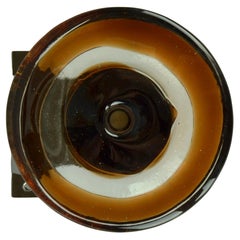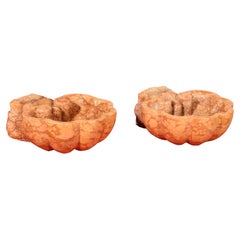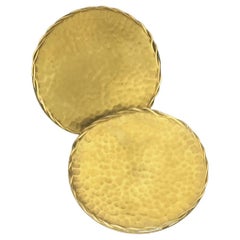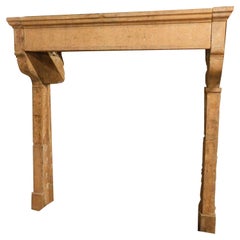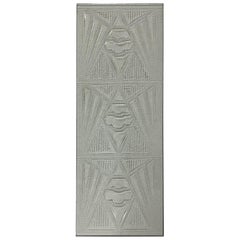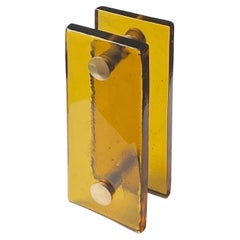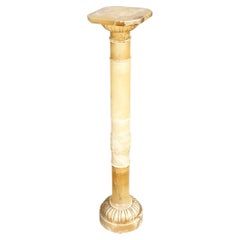Architectural Elements
17
1
to
1
10
8
18
18
18
3
2
1
1
4
2
11
1
1
5
3
1
1
2
1
Height
to
Width
to
4
4
4
3
2
9
6
6
4
3
1
Architectural Elements For Sale
Color: Orange
Color: Silver
Architectural Door Handle Round Push Pull in Clear and Amber Glass
Located in London, GB
Solid round glass push and pull door handle in clear and amber glass for a single door.
The handle can be applied inside or outside on a single door. It can also be used cupboard doors and kitchen...
Category
1970s European Minimalist Vintage Architectural Elements
Materials
Metal
Pair Of Marble Fonts - 19th Century
Located in Brussels, Brussels
Very nice pair of pink marble font from the 19th century
Very nice work from the south of France
In superb condition and beautiful patina
Category
19th Century French Rococo Antique Architectural Elements
Materials
Marble
Circular Push-Pull Door Handle in Brass, Mid-20th Century, France
Located in London, GB
Circular push-pull door handle in brass, with hammered texture. Mid-20th century. Found in France.
The handle is made up of two separate pieces with hammered texture; each trimmed...
Category
Mid-20th Century French Mid-Century Modern Architectural Elements
Materials
Metal, Brass
Antique Burgundy Stone Mantel Fireplace, 18th Century France
Located in Cuneo, Italy (CN)
Antique fireplace mantle in yellow Burgundy stone, carved with a central basket of flowers, without sides because it was set in the wall, built in the 18th century in France.
Ideal ...
Category
18th Century French Antique Architectural Elements
Materials
Stone
Stained Glass Window Panel
Located in Wormelow, Herefordshire
A stained glass window panel depicting a coat of arms, featuring a crown, elephant, song birds and clover. Originally fitted to a door.
Category
Early 20th Century Architectural Elements
Materials
Stained Glass
Antique Fireplace Mantle in Orange Burgundy Stone, 18th Century, France
Located in Cuneo, Italy (CN)
Ancient and important mantel fireplace, hand-carved in burgundy stone, with typical orange color of the stone, it was built for large room / kitchen for historic building of the 18th...
Category
18th Century Italian Antique Architectural Elements
Materials
Stone
Fish Tape Measure, Hammered Silver
Located in Vienna, AT
A fish tape measure made of hammered silver.
Category
20th Century Architectural Elements
Materials
Silver
XL Blueprint Copy of “Proposed Golden Gate Bridge Crossing of San Francisco”
Located in San Francisco, CA
A fascinating and expansive six-foot-wide 1950s copy on paper of a historically important and rare 1923 panoptic engineering blueprint titled “Proposed Highway Crossing - San Francisco to Sausalito” by John G. Little & Co. It depicts a pair of suggested solutions for bridging the world famous Golden Gate, the mile-wide strait where San Francisco Bay meets the Pacific Ocean.
Both crisply rendered San Francisco-to-Sausalito crossings are meticulously drafted in full at 1” = 400’ scale, with each having a total length of 22,780 feet (4.31 miles). The proposal at top depicts a high-level bridge with three 1,100 ft. spans, and the proposal at bottom depicts a combination trestle-and-tube design that presciently evokes the similarly submerged Transbay Tube that would open fifty years later nearby. Little estimated their respective costs to be $14,000,000 and $11,000,000—or approximately $215,333,000 and $169,190,000 when adjusted for inflation.
As shown in the aerial view map at top right, the proposed connection points would’ve been near where Van Ness...
Category
1950s American Industrial Vintage Architectural Elements
Materials
Paper
Massive Orange Lacquered Planters by Architectural Fiberglass
Located in Dallas, TX
Perfectly simple, modern forms in an extraordinary scale planters by Architectural fiberglass. Radical for their time, their pure forms, startled the eye in 1950s America, where fat-...
Category
1970s American Mid-Century Modern Vintage Architectural Elements
Materials
Fiberglass
Scalamandre by Brian Coleman, Dan Mayers 'Photographer' Signed 1st Ed
Located in valatie, NY
Scalamandre by Brian Coleman and Dan Mayers (Photographer). Gibbs Smith, Publisher, Utah, 2004. Stated 1st Ed hardcover with dust jacket. The book is ins...
Category
Early 2000s American Architectural Elements
Materials
Paper
White Pillars Early Life & Architecture Of The Lower Mississippi Valley, 1st Ed
Located in valatie, NY
White Pillars: Early Life & Architecture Of The Lower Mississippi Valley Written by and Illustrated by J. Frazer Smith. New York: William Helburn, 1941. 2...
Category
1940s American Vintage Architectural Elements
Materials
Paper
N.2 Antique Orange Lacquered Doors with Wooden Tinsel Hand Carved, Italy 1700
Located in Cuneo, Italy (CN)
Set of two antique orange lacquered doors with brown wooden concihlie, hand carved, real and very beautiful wood with patina, built in Italy in the late 1700s.
Beautiful in front an...
Category
1780s Italian Antique Architectural Elements
Materials
Wood
Antique Double Frame, Orange Faux Marble Lacquered Arch, 19th Century, Italy
Located in Cuneo, Italy (CN)
Antique double frame, painted in the same way on both sides, has an arch shape, hand painted with brown decorations on a fake orange marble lacque...
Category
19th Century Italian Antique Architectural Elements
Materials
Wood
Antique Fireplace in Red Marble with Carved Central Shell, 18th Century, Italy
Located in Cuneo, Italy (CN)
Ancient fireplace in "Breccia Pernice" red marble, with hand carved shell on the fronton of the fireplace, bold color and precious marble, typical of its eighteenth century, coming f...
Category
18th Century Italian Antique Architectural Elements
Materials
Breccia Marble
Large Modular Cast Aluminum Orange Yard Art Indoor Outdoor Playground Sculpture
Located in Ferndale, MI
Modular in that this is three pieces of cast aluminum. Each has been sand blasted and powder coated. Measures 75" tall assembled.
Category
Mid-20th Century American Mid-Century Modern Architectural Elements
Materials
Aluminum
English Georgian Style Satinwood Panel
By Robert Adam
Located in New York, NY
English Georgian style (20th Century) marquetry & satinwood panel with guilloche border (in the manner of ROBERT ADAMS).
Category
20th Century British Georgian Architectural Elements
Materials
Satinwood
Early Antique Collection of Eight Bone Glove Stretchers Made in France
Located in Stamford, CT
Collection of eight antique spring action bone glove stretchers made in France. The large ones measure 8 inches, the smaller at 6 inches.
Category
Mid-20th Century Industrial Architectural Elements
Building by the Book Volumes 1 & 2 First Edition
Located in valatie, NY
Building by the Book Volumes I & 2, Building by the Book, by Center for Palladian Studies in America. University Press of Virginia, Charlottesville, VA, 1984-1986. Pair of 1st Ed har...
Category
1980s American Vintage Architectural Elements
Materials
Paper
Related Items
Architectural Glass #1
Located in Oakville, CT
Handmade Glass Panels
Multiples Available
Dimensions: 9" x 24 1/2" x 1/4" thick
Category
Mid-20th Century American Architectural Elements
Materials
Glass
Arne Jacobsen Brass Door Handle Sets in Solid Brass
Located in Copenhagen, DK
Arne Jacobsen - Scandinavian Modern
Original, solid brass door handles. Beautiful organic shape. An iconic design for both modern and classic interiors.
Designed for the SAS H...
Category
Mid-20th Century Danish Mid-Century Modern Architectural Elements
Materials
Brass
Art Nouveau Curved Stained Glass & Bronze Panel/ Window, Attributed to Tiffany
Located in New York, NY
This stunning Art Nouveau window/ panel was realized in the United States in 1907, attributed to Tiffany & Co. The piece features a mosaic of int...
Category
Early 1900s American Art Nouveau Antique Architectural Elements
Materials
Bronze
H 26.5 in W 46 in D 11 in
Set of Four Italian Stained Glass Door- Window Panels, Italy 1890 circa
Located in Sacile, PN
Set of four Italian Stained Glass door- window Panels, Italy 1890 circa
Measure: Each door/panel measures height cm. 210,5, width cm. 51 and just ...
Category
1890s Italian Arts and Crafts Antique Architectural Elements
Materials
Lead
H 73.63 in W 81.89 in D 0.79 in
Architectural Glass #3
Located in Oakville, CT
Handmade Glass Panels
Multiples Available
Dimensions: 8 1/2" x 20 1/4" x 1/4" thick
Category
Mid-20th Century American Architectural Elements
Materials
Glass
Antique Fireplace 18th Century Louis XIII France
Located in Made, NL
Very imposing antique castle fireplace from the 18th century! A beautiful fireplace in the style of Louis XIII with various ornaments and gravings and beautiful lines in the top of t...
Category
18th Century French Other Antique Architectural Elements
Materials
Limestone
Set of four "Liberty" Italian Stained Glass door- window Panels, Italy 1900 ca.
Located in Sacile, PN
Set of four "Liberty" Italian Stained Glass door- window Panels, Italy 1900 c
Measure: Each door/panel measures height cm. 187, width cm. 52 a...
Category
Early 1900s Italian Arts and Crafts Antique Architectural Elements
Materials
Lead
H 73.63 in W 81.89 in D 0.79 in
Set of 3 Art Deco Glass Door Handles with Plates
Located in Dallas, TX
Presenting a gorgeous set of 3 Art Deco glass door handles with plates.
Amazingly complete set!
Probably made in the US circa 1925-30.
These ar...
Category
Early 20th Century American Art Deco Architectural Elements
Materials
Chrome
19th Century Stained Glass Victorian House Number Window Panel, circa 1880
Located in San Francisco, CA
19th century stained glass Victorian House Number window panel circa 1880
Fantastic antique over the door window panel showing the street number...
Category
Late 19th Century American Late Victorian Antique Architectural Elements
Materials
Art Glass
Bronze Door Handle and Bell Push with Brutalist Design 20th Century, European
Located in London, GB
A rectangular bronze push or pull door handle, with Brutalist geometric design, together with matching bell push, mid-late 20th century, European.
This is a heavy handle, made of ca...
Category
Mid-20th Century European Mid-Century Modern Architectural Elements
Materials
Brass, Bronze
H 6.82 in W 4.34 in D 2.6 in
Selection of eight restored 19th C Neo-Gothic Stained-Glass Windows
Located in Leuven , BE
The Color Experience: Stained-glass windows
“Color is a power which directly influences the soul” (Wassili Kandinsky, Moskou 1866 – Neuilly-sur-Seine, 1944)
“Color! What a deep and mysterious language, the language of dreams!” (« La couleur ! Quelle langue profonde et mystérieuse, le langage des rêves », Paul Gauguin, Paris, 1848-Fatu-Hiva, 1903)
‘Color and feeling’, ‘color and meaning’, these are concepts that have gone together since time immemorial. Artists and craftsmen have a special bond with color. After all, it is a means of expression that can have a real reinforcing effect. Especially linking color with light offers unlimited possibilities. Glaziers and glass painters have tried to master both these ‘instruments’ for centuries.
The set of beautifully restored neo-Gothic windows in our collection are enough reason for us to let these works of art figure in a broader story. As a bonus, we would like to introduce you to the contemporary stained-glass artist and stained-glass restorer, Daniël Theys. whose workshop is in Sint-Pieters-Rode (Belgium). He talked to us about the materials and techniques he used for the restoration of our set of neo-Gothic stained-glass windows. A fascinating look at the tricks of the trade from a specialist!
A bird’s eye view of the history of the European stained-glass window.
Although the Romans already used translucent glass plates to cover wall openings, the stained-glass window reached its peak in Europe between 1150 and 1500. A period also known as the era of the cathedrals. At that time, stained-glass windows became more than just a way to let in the light, and to keep the space closed off. From now on, their functionality was also found in their didactic value. The biblical and saints’ stories that adorned the stained-glass windows became a kind of poor man’s bible. They brought, as it were, the knowledge of the holy scriptures in an understandable, pictorial way. At the same time, the colored light provided additional symbolism. The invading light was interpreted as a manifestation of God. It is also no coincidence that the main altar was bathed in light. It was the place where the most important sacrament was celebrated, that of the Eucharist. How were these magical colors obtained? Well, during the 12th and 13th centuries, metal oxides gave color to the glass. Copper, for example, produced different colors in the various stages of oxidation. The metal could color the glass light blue, green and even red. It should be noted that from the 13th century onwards, clear glass, which was cheaper and at the same time allowed more light into the buildings, was used more often. A century later, in the years 1400 to 1500, glass painters frequently painted onto the glass with a ‘stain’ of silver chloride or sulfide. The painted piece of glass was heat-treated in a furnace. The heating process ensured that the silver ions migrated into the glass and became suspended within the glass network. The stain gave colors ranging from a pale yellow to a rather deep red. This new technique allowed glaziers to get more than one color on a single glass fragment. The shades produced by painting in silver chloride were well suited for depicting golden crowns, scepters and other gilded objects and ornaments. But the most important advantage of the technique was the fact that the glass painter could now make transitions from yellow tones to white without having to apply separations with lead strips! This also improved the legibility of the pictured scene.
You can imagine that the labor-intensive process of the production of stained-glass windows was a very costly affair and therefore it was often patrons who donated them to a church or a chapel. The benefactors were usually eager to propagate their social status and were moved by concern for their salvation.
In the 16th century, stained-glass windows also began to appear in secular buildings such as town halls, the homes of the wealthy and commercial premises such as inns. It is striking that during this period the use of lead strips that border many parts of the image was further reduced in favor of real painting on stained glass. This was due to an increasing love of detail. For example, one wanted realistically painted portrait heads. Working with enamel paints was cumbersome. Each newly applied color had to be burned into the glass before another color or overpainting could be applied. It was not only the coloring of the glass that was complicated, the process of obtaining flat glass plates required many steps as well. The glazier blew a glass bulb with a blowpipe and then cut it open. Finally, each half of the sphere was turned around so fast that it became a disc. In later periods, the glazier blew out his glass bulb into a cylinder. Once the cylinder had cooled, its closed ends were removed, and the long sides were cut open. The pieces of glass obtained were then heated and flattened. During the 16th century, there was a division of labor between the stained-glass designer, the glazier, and the glass painter. It happened as well that the stained-glass artist used prints as models for his stained-glass windows. Whoever drew the design, the glazier always needed a model on the right scale, the so-called cartoon. On the cartoon, the lead strips were clearly marked, and the use of colors was indicated. Contracts at the time show that the price of stained-glass windows was calculated per square foot. The price per square foot included the labor and material costs. The price of the cartoon was not included.
In the 17th century, the work of glass painters remained important. At the same time, there was a growing popularity of stained-glass windows with heraldic themes. In the Low Countries there were several high-quality glass painters active.
During the 18th century, glass painting went downhill in our regions. The French occupation of the Southern Netherlands resulted in the destruction and sale of religious stained-glass windows.
It was only around the middle of the 19th century that the young Belgian state experienced a revival of stained glass. The renewed interest in the Middle Ages, the so-called ‘gothic revival’, caused a wave of restoration of old stained-glass windows of churches and orders for neo-gothic stained-glass windows. The Sint-Lucas art schools in Belgium played an important role in this. Industrial developments in the glass and steel industries naturally had an important hand in the popularity of stained-glass windows. Stained-glass had a wide range of uses; think of stained glasses in winter gardens, domes, windows, and doors of large mansions. Significant glazier’ studios arose in several larger Belgian cities. In Brussels, for example, you had the workshops of Capronnier and Colpaert, in Bruges the studios of Coucke and Dobbelaere, in Ghent the companies of Ganton-Defoin or Ladon. During the 19th century, glaziers followed the style developments in the visual arts. For example, the number of windows in Art Nouveau and Art Deco style is large. The restored stained-glass windows with male and female saints that we offer for sale, come from a building in Laeken, near Brussels. They probably decorated the space of a church, chapel, convent, or Catholic school. In the results of the interview with glass restorer Daniël Theys, you will learn more about the particularities of these splendid windows.
Chatting and browsing in the workshop of Daniël Theys
The Belgian Glass restorer and glass blower, Daniël Theys (), made a career switch at a later age and has been active in the profession since 1987. He is an important player in the field of stained-glass window art in Belgium. Moreover, he is the only one in the country who still masters the technique of glass etching. Daniël Theys receives many commissions from small parish churches to restore old stained-glass windows to their former glory. He made a name for himself in that niche and that is how Spectandum brought the set of 19th century stained glass windows to his workshop for reconstruction. They were delivered in old numbered wooden crates and Daniel had to start puzzling.
Numbered wooden crates with sections of the stained-glass windows
Normally a glazier starts working from a drawing with a scale of 1:1 (full size drawing), but in this case each piece had to be cataloged and photographed. The smaller pieces were grouped on the light box and photographed in their entirety. Then Daniël made a drawing of the remaining pieces that he had puzzled together with great care.
Smaller pieces identified and grouped on the light box
The restauration guidelines of the Agency for Monuments and Landscapes are not always the same as those of a restorer. For this reconstruction, Daniël primarily considered the purpose of the stained-glass windows. It had to be an aesthetic and salable set of stained-glass windows, so the choice of filling the gaps with neutral glass or epoxy was not really an option. Theys left well-executed previous restorations untouched. The windows may have been repaired three or four times in the past.
Piece of a cloak with glass shards from different periods (restorations)
Another problem Daniel faced during the restoration was the fact that some small parts of the old grisaille had been eaten away by microorganisms. The defect – caused by moisture – can be seen from the discoloration of the grisaille. The black-brown color is turned red.
This fragment shows well how the brown grisaille has turned red due to the attack of micro-organisms
The stained-glass windows of the 19th century are made of ‘in the mass-colored’ glass. This means that the colors were added to the liquid glass during its production process. This type of glass differs from glass colored with enamel paint, which became popular from the interwar period. The latter process involves applying enamel paint (this is a glass powder with a metal oxide to which a medium has been added) to the colorless glass. When firing the glass with the enamel paint, the powder fuses with the glass. The colors of email painted glass are less intense and less brilliant than those of ‘in the mass-colored glass’.
Jars with colored powder for the enamel paints
For the restoration Daniël only worked with mouth-blown glass, both with ‘in the mass-colored glass’ and with ‘verre plaqué’. This is blown glass composed of several layers of different shades. Over the years, Theys built up a large stock of old blown glass. Colored blown glass always has sliding shades. For example, a red piece of glass can have a color transition from bright red to light orange. These differences in shades are the result of the different thicknesses of the piece of glass. It allows the glazier to use a wide variety of shades.
The purple-red foliage with light blue accents was obtained by etching away parts of a piece ‘verre plaqué’. A small part of the lower glass layer is exposed.
The windows were completely re-leaded by the restorer because there was virtually no ‘lead net’ preserved. In general, lead strips only have a limited lifespan because of oxidation processes. Daniël removed the old lead remnants and placed new lead profiles. Then he applied putty between the glass fragments and the lead strips to seal the lead. A window must be made watertight. The current condition of the windows is excellent.
Decorative glass part with original lead remnants
New lead strip
The set of stained-glass windows we present today, originally consisted of windows of 5 to 6 m high. After all, they originally adorned a neo-gothic church. Since the original dimensions are not suitable for private buildings, it was decided to only restore the figurative representation.
The original spire of one of the windows
Thanks to a suspension eye, the window can be hung. There is also the possibility to place the window in an upright position.
Thanks to the craftsmanship of the Theys-Studio, we can once again enjoy the brilliance of color!
Looking for the missing link
The set of 19th-century stained-glass windows came into the possession of Spectandum without a clear provenance. The renowned Leuven antiques dealer, Cornelius Engelen, recalls that the windows came from a church in Laeken. There is no solid starting point for a search for the provenance. Based on the style of the stained-glass windows – most probably the late 19th century -, their religious iconography, and their original shape (pointed arch windows) and dimensions (5 to 6 cm high), we can assume that they were once displayed in a (neo-)gothic cult building. On the one hand, the stained-glass windows may have been removed after storm damage or other calamities, on the other they may have been taken away during a renovation or a demolition of a church. The Church of Our Lady in Laeken is the most famous church building in that municipality that could qualify. In the early 1920s, the central windows of the transept were badly damaged by a hurricane. Today, glass fragments of these windows (dating from 1893-1894) with the names of the sixteen missing saints and an arch infill of the western window are officially known. It would be interesting to find out if our set of eight saints once were part of the transept of Our Lady in Laeken. Research in the records of the church administrators could provide clarification. Knowing that most neo-gothic stained-glass windows from the Church of Our Lady come from the Jules Dobbelaere’s glass studio in Bruges, it is useful to consult that company’s archive as well. It is kept in the KADOC (Documentation and research center for religion, culture and; in Leuven. Of course, the sizes and shape of the stone window openings of the transept can also provide an indication. If we stylistically compare the grisailles of the set of stained-glass windows with the work of Jules Dobbelaere, we do see some relationship. Especially with a stained-glass window in the chapel of Our Lady of the Saint Anthony Church in Aalst.
Another line of research that we could follow, is that of the iconography of the series. One of the saints depicted is Saint Roch. There once was a Saint-Roch church in Laeken with 19th-century stained-glass windows from the Brussels studio of Jean-Baptiste Capronnier. The company archive of the glaziers François and Jean-Baptiste Capronnier is owned by the Flemish government and can be consulted in the above-mentioned KADOC. We already searched the sales catalog of 1892, in which Capronnier’s drawings and cartoons are described one by one. The saints that are represented in our set of windows, does not correspond with the names of the saints mentioned for the church of St. Roch in Laeken. Building on this argument, it can be concluded that the eight saints were not destined for this house of worship.
In the absence of lavishly illustrated monographs on the various glazier-companies in Belgium, the execution of a comparative study of the stained-glass windows is time-consuming and complex. Although a limited number of old photos of stained-glass windows can still be found in the database ‘Balat’ of the KIK-IRPA (), this remains far too limited to get a good picture of the output of the various companies.
19th C, Saint, Neo-Gothic Stained-Glass Window with Saint Martin, Belgium, 163 x 73 cm
Most people know Saint Martin (Szombathely, ca. 316 – Candes, 397) as the Roman Tribune who cut his cloak in two with his sword and gave one half to a beggar. The artist of the stained-glass window has opted for a different, less common iconographic representation here. Saint Martin is presented as a bishop with a miter and staff. According to a legend, Martin was lured to the city of Tours with a trick to consecrate him as a bishop. He refused the ecclesiastical office and hid in a barn with some geese. The birds betrayed him with their twittering. In the end Martin received his episcopal consecration. The goose at the feet of the saint clearly refers to this event.
19th C, Saint, Neo-Gothic Stained-Glass Window with St. Angela, Belgium, 163 x 73 cm
Angela de Merici was an Italian woman who taught young women religion, health care, and household skills. She founded the monastic community of the Ursulines. They played an important social role as founders of schools and orphanages. Saint Angela died in Brescia in 1540. It should therefore come as no surprise that the saint on the stained-glass-window is depicted with
a girl by her side.
19th C, Saint, Neo-Gothic Stained-Glass Window with Charles Borromeo, Belgium, 163 x 73 cm
Charles Borromeo (Milan, 1538-1584) grew up in a noble family. He was already made Cardinal and Archbishop of Milan at the age of 24. With his writings he contributed to the implementation of the Church reforms determined at the Council of Trent. Among other things, he released a new catechism. With his book on the design of church buildings, “Instructiones Fabriacae et Supellectilis Ecclesiasticae”, he left a mark on Baroque church construction. At the outbreak of the plague in his diocese in 1576, he devoted himself to the care of those affected. Hence, people sometimes pray to him when they have been hit by a serious illness.
19th C, Saint, Neo-Gothic Stained-Glass Window with St. Roch, Belgium, 163 x 73 cm
Saint Roch (Montpellier, 1295? /1350? -1327? /1380?) was born with a port-wine stain in the shape of a cross on his left hip. It was interpreted as a sign from God. After the dead of his parents, he gave his money to the poor and went on to live the life of pilgrim. He cared for plague sufferers and healed some of them by making a sign of the cross. He is especially invoked as protector against the plague.
19th C, Neo-Gothic Stained-Glass Window with St. Bernard of Clairvaux, Belgium, 163 x 73 cm
Bernard of Clairvaux (Fontaines, 1090-Clairvaux, 1153) decided to become a monk at the age of 21. In 1112 he entered in the monastery of Cîtaux. He was soon commissioned by the abbot to find a new monastery in Clairvaux. Because of his intellectual capacities and eloquence, he was consulted by various ecclesiastical and secular leaders. He ensured the expansion of the Cistercian order throughout Europe. As a Doctor of the Church, he wrote many tracts and sermons and established a new rule for the Templars. Above all, he was concerned with the discipline of the clergy. Therefore, he wrote a spiritual manual for the priests and bishops. Saint Bernard can be seen as a true mystic. He envisioned the union of the human soul with God as the most important goal in life. According to a legend, Bernard once had a vision in which the Blessed Virgin appeared to him and strengthened him with her mother’s milk. In the arts, the saint is mainly depicted with an abbot’s staff and a book with the Cistercian rule. His vision was also often portrayed.
19th C, Neo-Gothic Stained-Glass Window with St. John Berchmans, Belgium, 163 x 73 cm
The Belgian Jan Berchmans (Diest, 1599-Rome, 1621) was the eldest of five children. When his mother became seriously ill, he initially took care of her, but at the age of nine he was housed with the town’s priest. After a few years he moved to Mechelen to become the servant of a canon. It also gave him the opportunity to begin his studies in the seminary for priests. He eventually joined the Jesuits of Mechelen. He got their permission to study philosophy in Rome. In the Eternal City, he visited working-class neighbourhoods to teach the children about God. He died of an illness at the age of 22. Saint Jan Berchmans is the patron saint of school children and students.
19th C, Neo-Gothic Stained-Glass Window with Saint Clare...
Category
19th Century Belgian Gothic Revival Antique Architectural Elements
Materials
Art Glass, Stained Glass
Brass Palais Door Handle by Henry Wilson
By Henry Wilson
Located in Geneve, CH
Brass Palais Door Handle by Henry Wilson
Dimensions: W 13 x D 8 x H 2 cm
Materials: Brass
Palais lever handle in high tensile brass or aluminium. Each ha...
Category
2010s Australian Modern Architectural Elements
Materials
Brass
Previously Available Items
Set of Large Amber-Coloured Glass Handles, France 20th Century
Located in London, GB
A set of large push-pull handles made up of two large glass pieces with their fixings. France second half 20th century. Former shop fittings.
Each of the two striking glass slabs is unique, with all the characteristics of handcrafted work including small bubbles, folds and imperfections from the making process; the soft amber tone appears lighter or darker depending on the levels of direct light. The large glass slabs are in good condition, with minor signs of age-appropriate wear including small nicks and light scratches. The brass (or bronze) fixings have been refinished and lightly polished; they have minor signs of age and use and are unlaquered, so will darken with age.
Installation
The set is supplied with the original fixings as shown in image 8; there is some wear to the internal parts, including the nylon buffers, however they are not visible on installation, and all pieces function well. The handles have previously been used either side of a single door, however you could amend or replace the central rod to use the handles on a thicker door...
Category
20th Century French Mid-Century Modern Architectural Elements
Materials
Brass
Italian Modern Alabaster Column Finely Worked, 1980-2000s
Located in MIlano, IT
Italian modern Alabaster column finely worked, 1980-2000s.
Elegant and classic column in alabaster with a round base in cream yellow color. The top is square with cut corners. The c...
Category
1980s Italian Classical Roman Vintage Architectural Elements
Materials
Alabaster
Antique German Silver Sink Almost Long in Very Nice All original Condition
Located in Chicago, IL
First introduced to Chicago by Leopold & Louis Katz with Ellef Robarth, a tinsmith who came up with a concept to fabricate German silver sinks and d...
Category
1920s American Vintage Architectural Elements
Materials
Metal
H 12 in W 117 in D 22.13 in
White Pillars: Early Life & Architecture Of The Lower Mississippi Valley, 1st Ed
Located in valatie, NY
White Pillars: Early Life & Architecture Of The Lower Mississippi Valley Written by and Illustrated by J. Frazer Smith. New York: William Helburn, 1941. 2...
Category
1940s American Vintage Architectural Elements
Materials
Paper
H 11.25 in W 8.75 in D 1 in
Antique Wooden Door Painted with Frame, Orange White, 18th Century, Italy
Located in Cuneo, Italy (CN)
Antique solid wood door, indoor, hand painted with Classic landscape, back with painted panel and therefore well finished, original frame with ...
Category
18th Century Italian Antique Architectural Elements
Materials
Wood
Architectural Square Push Pull Pair of Double Door Handle in Orange Glass
Located in London, GB
Pair of orange glass cast square glass push and pull door handles with bronze color fittings designed for a glass door, French, 1960's.
The fixings can be adjusted for wooden doors.
...
Category
1970s French Mid-Century Modern Vintage Architectural Elements
Materials
Brass
H 8.27 in W 8.27 in D 4.73 in
N. 1 Antique Double-Leaf Doors, Hand Painted Orange Black, 18th Century, Italy
Located in Cuneo, Italy (CN)
N.1 antique double-leaf interior doors, without frame but painted on an orange and black background, both front and back the same, very precious with a rich and well executed Baroque...
Category
18th Century Italian Antique Architectural Elements
Materials
Wood
H 86.62 in W 48.82 in D 1.97 in
Exceptional Copper and Silver Beveled Wall Mirror
Located in Delray Beach, FL
One of a kind mirror made by Spanish maker, copper frame with four silver accent motifs one on each corner, two decorative trimming line on each side, and beveled mirror. Beautiful o...
Category
20th Century Spanish Architectural Elements
Materials
Silver, Copper
KWC Switzerland Forma Yellow Black Postmodern Lavatory Faucet, Deck, Basin, 1997
Located in Brooklyn, NY
KWC Switzerland forma yellow and black Postmodern Lavatory Faucet, deck, basin, 1997. New in box. Never installed. Exceedingly rare design, made in Swi...
Category
Late 20th Century Swiss Post-Modern Architectural Elements
Materials
Brass
H 8 in W 3 in D 5 in
Midcentury Four Bronze Brass Sabot Leg Caps Cups Tips from Italy
Located in Chula Vista, CA
For your consideration: Four brass sabots aka caps, cups, tips used as furniture feet-shoes. Made of bronze brass serves to protect furniture legs and a...
Category
1950s Italian Hollywood Regency Vintage Architectural Elements
Materials
Brass
Mid-Century Modern Italian Glass Door Handles Enamel Art Studio Del Campo 1960s
Located in Chula Vista, CA
For your consideration: Mid-Century Modern Incredible Italian glass door handles copper enamel Art Studio Del Campo 1960s Torino Italy
Dimensions: ...
Category
1960s Italian Mid-Century Modern Vintage Architectural Elements
Materials
Enamel
H 12 in W 12 in D 6 in
Vintage Scandinavian Modern Damixa Faucet Fitting, Yellow, Denmark, 1983
Located in Brooklyn, NY
Vintage Scandinavian Modern Damixa faucet fitting, yellow, Denmark, 1983. Damixa invented the single handled faucet in 1966 and began using the iconic red / blue button in 1983. Extr...
Category
Late 20th Century Danish Scandinavian Modern Architectural Elements
Materials
Brass
Recently Viewed
View AllMore Ways To Browse
Antique Iron Fences
Antique Cupola
Antique Stone Capital
Architectural Antique Exchange
Belgian Antique Tiles
Iron Trellis
Antique Garden Trellis
Antique Garden Trellises
Railing Panel
Church Salvage
Round Architectural Window
Early 20th Century Architectural Salvage
Garden Shutters Wood
Antique Cast Iron Star
Antique Architectural Salvage Wood
Antique French Wood Fragments
Antique Wooden Fragments
Pool Surround
